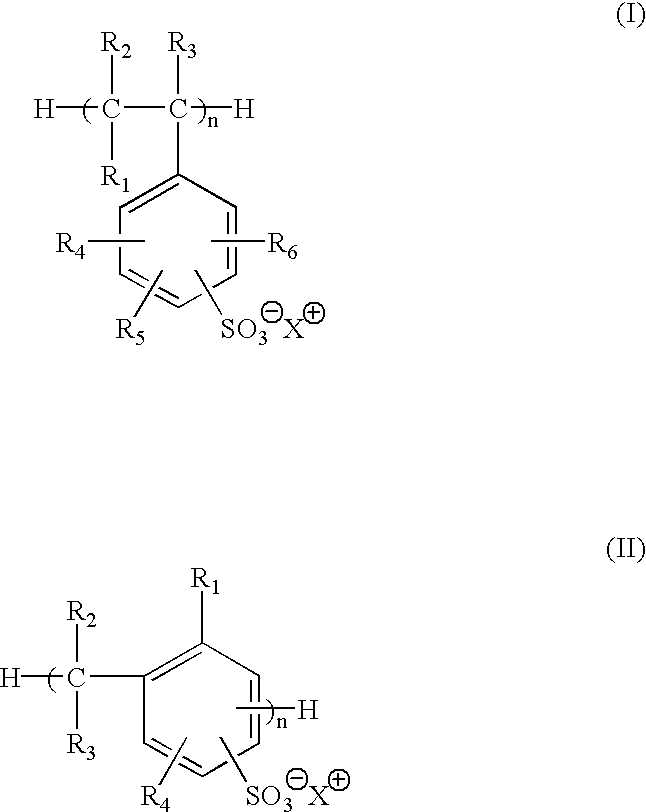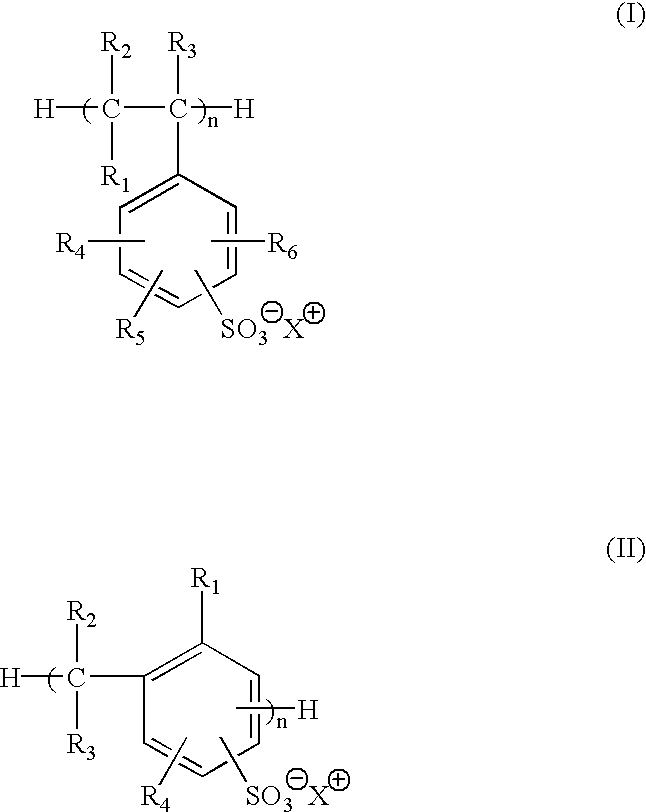Selected polymeric sulfonate acid generators and their use in processes for imaging radiation-sensitive elements
- Summary
- Abstract
- Description
- Claims
- Application Information
AI Technical Summary
Benefits of technology
Problems solved by technology
Method used
Image
Examples
synthesis example 1
[0125]Synthesis of 2-methoxy-4-(phenylamino)-benzenediazonium polystyrene sulfonate (MSPSS) acid generator.
[0126]0.50 g of sodium polystyrene sulfonate (Scientific Polymer Products, Inc., Ontario, N.Y.) in 50 ml of water was slowly mixed with 15 ml of 5% (wt %) 2-methoxy-4-(phenylamino)-benzenediazonium bisulfate (Diverstec, Fort Collins, Colo.) aqueous solution while stirring. The mixture was stored in dark at 0-5° C. for 5 hours. After decanting water, the resulting oil material was dried under nitrogen flow and the yield was 1.0 g. The product was then dissolved in 30 ml of γ-butyrolatone (BLO), and was stored in refrigerator for further use.
[0127]Proton NMR (in DMSO-d6): δ 0.4-2.4 (4H, br), 4.0 (3H, s), 6.5-7.0 (4H, m, br), 7.2-7.8 (7H, m, br), 8.1 (1H, s), and 10.8 (1H, s).
synthesis example 2
[0128]Synthesis of 2-methoxy-4-phenylamino)-benzenediazonium sulfonated phenolic resin (MSFC-369) acid generator.
[0129]10 g of sodium sulfonated phenolic resin FC-369 (3M, St. Paul, Minn.) in 150 ml of water was slowly mixed with 25 ml of 5% (wt %) 2-methoxy-4-(phenylamino)-benzenediazonium bisulfate (Diverstec, Fort Collins, Colo.) aqueous solution while stirring. The reaction mixture was stored in dark at 0-5° C. for 5 hours. The yellow solid was collected by filtration and then dried by vacuum. The yield was 8.8 g.
[0130]Proton NMR in DMSO-d6): δ 3.8 (2H, br), 4.0 (3H, s), 6.5-7.2 (5H, m), 7.2-8.2 (12H, m), 10.7 (1H, s) and 11.1 (1H, m).
example 3
Preparations of the Lithographic Plates
[0131]A coating solution was prepared by dissolving 5.6 g of 25% resole (GP649D99 resole resin from Georgia-Pacific, Atlanta, Ga.), 6.8 g of 34% N-13 novolak (Eastman Kodak Company, Rochester, N.Y.), 23 g of MSPSS (3.5% in BLO) prepared above, 0.42 of 2-[2-[2-chloro-3-[2-(1.3-dihydro-1,3,3-trimethyl-2H-benzeindol-2-ylidene)ethylidene ]-1-cyclohexen-1-yl]ethenyl]-1,3,3-trimethyl-1H-benzeindolium 4-methylbenzenesulfonate (Eastman Kodak Company, Rochester, N.Y.), 0.06 g of D11 colorant dye (PCAS, Longjumeau, France), and 0.2 g of 10% Byk-307 (Byk-Chemie, Wallingford, Conn.) in 30 g of 1-methoxy-2-propanol and 25 g of BLO. An electrochemically grained and anodized aluminum substrate, post-treated with polyvinylphosphoric acid (PVPA), was coated with above solution with a dry coating weight of about 120 mg / ft2. When properly dried at 190° F. for about 2 minutes on a rotating drum, the resulting plate was placed on a CREO® Trendsetter 3244x image set...
PUM
| Property | Measurement | Unit |
|---|---|---|
| Fraction | aaaaa | aaaaa |
| Fraction | aaaaa | aaaaa |
| Fraction | aaaaa | aaaaa |
Abstract
Description
Claims
Application Information
 Login to View More
Login to View More - R&D
- Intellectual Property
- Life Sciences
- Materials
- Tech Scout
- Unparalleled Data Quality
- Higher Quality Content
- 60% Fewer Hallucinations
Browse by: Latest US Patents, China's latest patents, Technical Efficacy Thesaurus, Application Domain, Technology Topic, Popular Technical Reports.
© 2025 PatSnap. All rights reserved.Legal|Privacy policy|Modern Slavery Act Transparency Statement|Sitemap|About US| Contact US: help@patsnap.com



